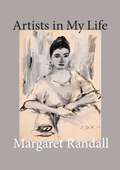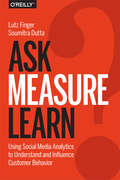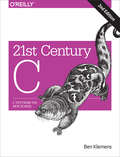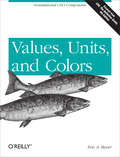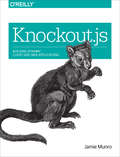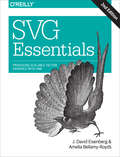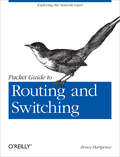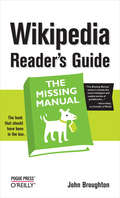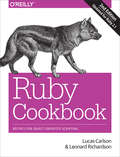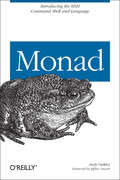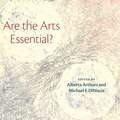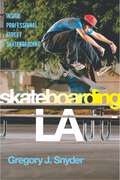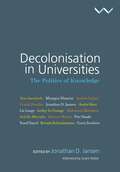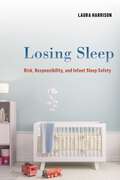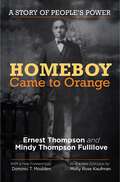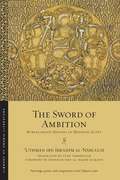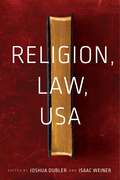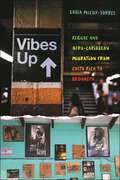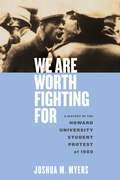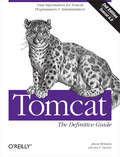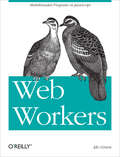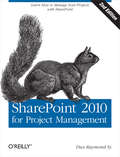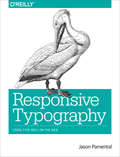- Table View
- List View
The Civil War Diary of Emma Mordecai (Goldstein-Goren Series in American Jewish History #25)
by Melissa R. Klapper Dianne AshtonA vivid look at the wartime experiences of a Jewish woman in the Confederate SouthEmma Mordecai lived an unusual life. She was Jewish when Jews comprised less than 1 percent of the population of the Old South, and unmarried in a culture that offered women few options other than marriage. She was American born when most American Jews were immigrants. She affirmed and maintained her dedication to Jewish religious practice and Jewish faith while many family members embraced Christianity. Yet she also lived well within the social parameters established for Southern white women, espoused Southern values, and owned enslaved African Americans.The Civil War Diary of Emma Mordecai is one of the few surviving Civil War diaries by a Jewish woman in the antebellum South. It charts her daily life and her evolving perspective on Confederate nationalism and Southern identity, Jewishness, women’s roles in wartime, gendered domestic roles in slave-owning households, and the centrality of family relationships. While never losing sight of the racist social and political structures that shaped Emma Mordecai’s world, the book chronicles her experiences with dislocation and the loss of her home.Bringing to life the hospital visits, food shortages, local sociability, Jewish observances, sounds and sights of nearby battles, and the very personal ramifications of emancipation and its aftermath for her household and family, The Civil War Diary of Emma Mordecai offers a valuable and distinct look at a unique historical figure from the waning years of the Civil War South.
Artists in My Life
by Margaret RandallMargaret Randall reveals personal stories and profound insights about the artists who most influenced her life.Artists in My Life is a collection of intimate and conversational accounts of the visual artists that have impacted the renowned poet activist Margaret Randall on her own journey as an artist. Randall writes of each relationship through multiple lenses: as makers of art, social commentators, women in a world dominated by male values, and in solitude or collaboration with communities and the larger artistic arena. Each story offers insight into the artist’s life and work, and analyses the impact it had on Randall’s own work and its impact on the larger art community. The work strives to answer bigger questions about visual art as a whole and its lasting political influence on the world stage. Randalls describes her motivations: ”I go beneath the surface, asking questions and telling stories. I have wanted to answer questions such as: Why is it that visual art—drawing, painting, sculpture, photography, architecture—grabs me and, in particular instances, feels as if it changes me at the molecular level? How do art and memory interact? How do reason and intuition come together in art? Do women and men make art differently? Does great art change the viewer? Does it change the artist? How does art travel through time?”
Ask, Measure, Learn: Using Social Media Analytics to Understand and Influence Customer Behavior
by Lutz Finger Soumitra DuttaYou can measure practically anything in the age of social media, but if you don’t know what you’re looking for, collecting mountains of data won’t yield a grain of insight. This non-technical guide shows you how to extract significant business value from big data with Ask-Measure-Learn, a system that helps you ask the right questions, measure the right data, and then learn from the results.Authors Lutz Finger and Soumitra Dutta originally devised this system to help governments and NGOs sift through volumes of data. With this book, these two experts provide business managers and analysts with a high-level overview of the Ask-Measure-Learn system, and demonstrate specific ways to apply social media analytics to marketing, sales, public relations, and customer management, using examples and case studies.
21st Century C: C Tips from the New School
by Ben KlemensThrow out your old ideas about C and get to know a programming language that’s substantially outgrown its origins. With this revised edition of 21st Century C, you’ll discover up-to-date techniques missing from other C tutorials, whether you’re new to the language or just getting reacquainted.C isn’t just the foundation of modern programming languages; it is a modern language, ideal for writing efficient, state-of-the-art applications. Get past idioms that made sense on mainframes and learn the tools you need to work with this evolved and aggressively simple language. No matter what programming language you currently favor, you’ll quickly see that 21st century C rocks.Set up a C programming environment with shell facilities, makefiles, text editors, debuggers, and memory checkersUse Autotools, C’s de facto cross-platform package managerLearn about the problematic C concepts too useful to discardSolve C’s string-building problems with C-standard functionsUse modern syntactic features for functions that take structured inputsBuild high-level, object-based libraries and programsPerform advanced math, talk to internet servers, and run databases with existing C librariesThis edition also includes new material on concurrent threads, virtual tables, C99 numeric types, and other features.
Values, Units, and Colors: Foundational CSS3 Components
by Eric A. MeyerNearly everything you do with CSS involves units for determining the look and formatting of your web page elements. With this concise guide, you’ll learn how to work with an array of units—including measurements and keywords—that help you define color, text, distance between elements, location of external files, and other values.This book contains chapters from the upcoming fourth edition of CSS: The Definitive Guide. When you purchase either the print or the ebook edition of Values, Units, and Colors, you’ll receive a significant discount on the entire Definitive Guide when it’s released. Why wait when you can learn how to use units and other key CSS3 features right away?Use RGB or HSL values to mix your own colors, and designate the degree of opacityLearn how to apply global keywords introduced in CSS3Use string values to wrap a sequence of text characters in quotesDescribe margins, letter spacing, and other properties, with either fixed or relative length unitsUnderstand how number, integer, and percentage values differExplore CSS3 unit types for describing display resolutionUse time values for transitions and animations
Knockout.js: Building Dynamic Client-Side Web Applications
by Jamie MunroUse Knockout.js to design and build dynamic client-side web applications that are extremely responsive and easy to maintain. This example-driven book shows you how to use this lightweight JavaScript framework and its Model-View-ViewModel (MVVM) pattern. You’ll learn how to build your own data bindings, extend the framework with reusable functions, and work with a server to enhance your client-side application with persistence. In the final chapter, you’ll build a shopping cart to see how everything fits together.If you’re a web developer with experience in JavaScript, HTML, and CSS, you’re ready for Knockout.Learn how to create a ViewModelBind HTML data and attributes, and CSS classes and stylesUnderstand data binding in Knockout’s context hierarchyUse properties that change dynamically through user interactionWork with forms by using several different bindingsBind multiple ViewModels on a single pageExtend or attach custom functions to observablesPerform server-side interactions with jQueryMap a JavaScript object or apply JSON data to a new object
SVG Essentials: Producing Scalable Vector Graphics with XML
by J. David Eisenberg Amelia Bellamy-RoydsLearn the essentials of Scalable Vector Graphics, the mark-up language used by most vector drawing programs and interactive web graphics tools. SVG Essentials takes you through SVG’s capabilities, beginning with simple line drawings and moving through complicated features such as filters, transformations, gradients, and patterns.This thoroughly updated edition includes expanded coverage of animation, interactive graphics, and scripting SVG. Interactive examples online make it easy for you to experiment with SVG features in your web browser. Geared toward experienced designers, this book also includes appendices that explain basic concepts such as XML markup and CSS styling, so even if you have no web design experience, you can start learning SVG.Create and style graphics to match your web design in a way that looks great when printed or displayed on high-resolution screensMake your charts and decorative headings accessible to search engines and assistive technologiesAdd artistic effects to your graphics, text, and photographs using SVG masks, filters, and transformationsAnimate graphics with SVG markup, or add interactivity with CSS and JavaScriptCreate SVG from existing vector data or XML data, using programming languages and XSLT
Packet Guide to Routing and Switching: Exploring the Network Layer
by Bruce HartpenceGo beyond layer 2 broadcast domains with this in-depth tour of advanced link and internetwork layer protocols, and learn how they enable you to expand to larger topologies. An ideal follow-up to Packet Guide to Core Network Protocols, this concise guide dissects several of these protocols to explain their structure and operation.This isn’t a book on packet theory. Author Bruce Hartpence built topologies in a lab as he wrote this guide, and each chapter includes several packet captures. You’ll learn about protocol classification, static vs. dynamic topologies, and reasons for installing a particular route.This guide covers:Host routing—Process a routing table and learn how traffic starts out across a networkStatic routing—Build router routing tables and understand how forwarding decisions are made and processedSpanning Tree Protocol—Learn how this protocol is an integral part of every network containing switchesVirtual Local Area Networks—Use VLANs to address the limitations of layer 2 networksTrunking—Get an indepth look at VLAN tagging and the 802.1Q protocolRouting Information Protocol—Understand how this distance vector protocol works in small, modern communication networksOpen Shortest Path First—Discover why convergence times of OSPF and other link state protocols are improved over distance vectors
Wikipedia Reader's Guide: The Missing Manual
by John BroughtonYou don't have to understand how to edit Wikipedia in order to find the information you need and join the conversation. This booklet gives you just what you need to know in friendly, concise form so you can research any subject without getting lost in Wikipedia's labyrinth. With it, you'll be able to unlock the mysteries of the many links on every Wikipedia page and the sometimes cryptic buzzwords you see on Talk pages.And, while this booklet focuses on Wikipedia readers, it also includes a tutorial for first-time editors and explains Wikipedia's editing tools. You'll find valuable advice on how to alert editors to flaws in articles and how to contribute to Talk pages without getting caught up in pointless disputes.The author of Wikipedia Reader's Guide: The Missing Manual has edited more than 15,000 Wikipedia articles, and has written a comprehensive index to Wikipedia for editors to use in their daily work. His knowledge of Wikipedia is limitless and his passion is contagious. With this guide, you'll catch on quickly.
Perl and XML: XML Processing with Perl
by Erik T. Ray Jason McIntoshXML is a text-based markup language that has taken the programming world by storm. More powerful than HTML yet less demanding than SGML, XML has proven itself to be flexible and resilient. XML is the perfect tool for formatting documents with even the smallest bit of complexity, from Web pages to legal contracts to books. However, XML has also proven itself to be indispensable for organizing and conveying other sorts of data as well, thus its central role in web services like SOAP and XML-RPC.As the Perl programming language was tailor-made for manipulating text, few people have disputed the fact that Perl and XML are perfectly suited for one another. The only question has been what's the best way to do it. That's where this book comes in.Perl & XML is aimed at Perl programmers who need to work with XML documents and data. The book covers all the major modules for XML processing in Perl, including XML::Simple, XML::Parser, XML::LibXML, XML::XPath, XML::Writer, XML::Pyx, XML::Parser::PerlSAX, XML::SAX, XML::SimpleObject, XML::TreeBuilder, XML::Grove, XML::DOM, XML::RSS, XML::Generator::DBI, and SOAP::Lite. But this book is more than just a listing of modules; it gives a complete, comprehensive tour of the landscape of Perl and XML, making sense of the myriad of modules, terminology, and techniques.This book covers:parsing XML documents and writing them out againworking with event streams and SAXtree processing and the Document Object Modeladvanced tree processing with XPath and XSLTMost valuably, the last two chapters of Perl & XML give complete examples of XML applications, pulling together all the tools at your disposal. All together, Perl & XML is the single book that gives you a solid grounding in XML processing with Perl.
Ruby Cookbook: Recipes for Object-Oriented Scripting
by Lucas Carlson Leonard RichardsonWhy spend time on coding problems that others have already solved when you could be making real progress on your Ruby project? This updated cookbook provides more than 350 recipes for solving common problems, on topics ranging from basic data structures, classes, and objects, to web development, distributed programming, and multithreading.Revised for Ruby 2.1, each recipe includes a discussion on why and how the solution works. You’ll find recipes suitable for all skill levels, from Ruby newbies to experts who need an occasional reference. With Ruby Cookbook, you’ll not only save time, but keep your brain percolating with new ideas as well.Recipes cover:Data structures including strings, numbers, date and time, arrays, hashes, files and directoriesUsing Ruby’s code blocks, also known as closuresOOP features such as classes, methods, objects, and modulesXML and HTML, databases and persistence, and graphics and other formatsWeb development with Rails and SinatraInternet services, web services, and distributed programmingSoftware testing, debugging, packaging, and distributingMultitasking, multithreading, and extending Ruby with other languages
Monad (AKA PowerShell): Introducing the MSH Command Shell and Language
by Andy OakleyWindows PowerShell, formerly know by its codename "Monad" and available now for Windows Server 2003, Windows XP, and Windows Vista, and soon for Exchange Server 2007 and MOM, is the future of Windows administration. From setting up automated build environments to managing 20,000 Exchange email clients in an organization, any tool that reduces the number of repetitive steps an administrator must perform, is a real win. Even better, PowerShell part of a major Microsoft initiative that aims to replace a host of Windows management tools with a single, unified shell. This is the promise of PowerShell and the reason IT professionals need to start learning how to use it today Reflecting the best of legacy tools such as bash and the Korn shell, PowerShell also breaks new ground in its command language design and its use of the object-oriented .NET Framework. And there is no better way to learn how to put PowerShell to work than to get your hands on Monad, O'Reilly's innovative, hands-on introduction to the tool. This concise 200-page book is an exciting tour of some of the new capabilities thatPowerShell puts into the hands of system administrators and power users, and is the perfect complement to existing PowerShell documentation. With more than 40 hands-on activities, the book covers every angle, from using PowerShell commands and its object-oriented pipelines to querying systems, generating reports and writing scripts that automate existing tasks. Adding to the lure is the fact that the book is written by Microsoft manager, Andy Oakley with a Foreword by PowerShell architect Jeffrey Snover-so you can be certain that it's teeming with inside information. Monad lets you see for yourself how PowerShell can significantly improve your productivity. Because the PowerShell technology has wide appeal, so, too, does this compact guide. Developers, administrators, and power users alike can all benefit from its insight. If you're someone who habitually drifts toward the c-m-d keys, knows all of the switches to most command tools, or spends time authoring batch files to solve new challenges, this book is right up your alley. And if your organization plans to upgrade soon to Exchange 2007 or MOM V3, there's no time to waste. Breaking News: A PowerShell RC1 Update to the book is now available at no charge from the book's catalog page on oreilly.com!
Are the Arts Essential?
by Alberta Arthurs Michael F. DiNisciaA timely and kaleidoscopic reflection on the importance of the arts in our societyIn the midst of a devastating pandemic, as theaters, art galleries and museums, dance stages and concert halls shuttered their doors indefinitely and institutional funding for entertainment and culture evaporated almost overnight, a cohort of highly acclaimed scholars, artists, cultural critics, and a journalist sat down to ponder an urgent question: Are the arts essential? Across twenty-five highly engaging essays, these luminaries join together to address this question and to share their own ideas, experiences, and ambitions for the arts. Darren Walker discusses the ideals of justice and fairness advanced through the arts; Mary Schmidt Campbell shows us how artists and cultural institutions helped New York overcome the economic crisis of the 1970s, bringing new investment and creativity to the city; Deborah Willis traces histories of oppression and disenfranchisement documented by photographers; and Oskar Eustis offers a brief history lesson on how theaters have built communities since the Golden Age of Athens. Other topics include the vibrancy and diversity of Muslim culture in America during a time of rising Islamophobia; the strengthening of the common good through the art and cultural heritages of indigenous communities; digital data aggregation informing and influencing new art forms; and the jazz lyricisms of a theater piece inspired by a composer’s two-month coma. Drawing on their experiences across the spectrum of the arts, from the performing and visual arts to poetry and literature, the contributors remind readers that the arts are everywhere and, in one important way after another, they question, charge and change us. These impassioned essays remind us of the human connections the arts can forge—how we find each other through the arts, across the most difficult divides, and how the arts can offer hope in the most challenging times. What answer does this convocation offer to Are the Arts Essential? A resounding Yes.
Skateboarding LA: Inside Professional Street Skateboarding (Alternative Criminology #10)
by Gregory J. SnyderInside the complex and misunderstood world of professional street skateboardingOn a sunny Sunday in Los Angeles, a crew of skaters and videographers watch as one of them attempts to land a “heel flip” over a fire hydrant on a sidewalk in front of the Biltmore Hotel. A staff member of the hotel demands they leave and picks up his phone to call the police.Not only does the skater land the trick, but he does so quickly, and spares everyone the unwanted stress of having to deal with the cops. This is not an uncommon occurrence in skateboarding, which is illegal in most American cities and this interaction is just part of the process of being a professional street skater. This is just one of Gregory Snyder’s experiences from eight years inside the world of professional street skateboarding: a highly refined, athletic and aesthetic pursuit, from which a large number of people profit. Skateboarding LA details the history of skateboarding, describes basic and complex tricks, tours some of LA's most famous spots, and provides an enthusiastic appreciation of this dangerous and creative practice. Particularly concerned with public spaces, Snyder shows that skateboarding offers cities much more than petty vandalism and exaggerated claims of destruction. Rather, skateboarding draws highly talented young people from around the globe to skateboarding cities, building a diverse and wide-reaching community of skateboarders, filmmakers, photographers, writers, and entrepreneurs. Snyder also argues that as stewards of public plazas and parks, skateboarders deter homeless encampments and drug dealers. In one stunning case, skateboarders transformed the West LA Courthouse, with Nike’s assistance, into a skateable public space.Through interviews with current and former professional skateboarders, Snyder vividly expresses their passion, dedication and creativity. Especially in relation to the city's architectural features—ledges, banks, gaps, stairs and handrails—they are constantly re-imagining and repurposing these urban spaces in order to perform their ever-increasingly difficult tricks. For anyone interested in this dynamic and daunting activity, Skateboarding LA is an amazing ride.
Decolonisation in Universities: The politics of knowledge
by Jonathan D. JansenIn this collection of case studies and stories from the field, South African scholars come together to trade stories on how to decolonise the universityShortly after the giant bronze statue of Cecil John Rhodes came down at the University of Cape Town, student protestors called for the decolonisation of universities. It was a word hardly heard in South Africa’s struggle lexicon and many asked: What exactly is decolonisation? This edited volume brings together the best minds in curriculum theory to address this important question. In the process, several critical questions are raised: Is decolonisation simply a slogan for addressing other pressing concerns on campuses and in society? What is the colonial legacy with respect to curriculum and can it be undone? How is the project of curriculum decolonisation similar to or different from the quest for postcolonial knowledge, indigenous knowledge or a critical theory of knowledge? What does decolonisation mean in a digital age where relationships between knowledge and power are shifting?The book combines strong conceptual analyses with novel case studies of attempts to ‘do decolonisation’ in settings as diverse as South Africa, Uganda, Tanzania and Mauritius. Such a comparative perspective enables reasonable judgements to be made about the prospects for institutional take-up within the curriculum of century-old universities.
Losing Sleep: Risk, Responsibility, and Infant Sleep Safety
by Laura HarrisonNew insights into the anxiety over infant sleep safetyNew parents are inundated with warnings about the fatal risks of “co-sleeping,” or sharing a bed with a newborn, from medical brochures and website forums, to billboard advertisements and the evening news. In Losing Sleep, Laura Harrison uncovers the origins of the infant sleep safety debate, providing a window into the unprecedented anxieties of modern parenthood. Exploring widespread rhetoric from doctors, public health experts, and the media, Harrison explains why our panic has reached an all-time high. She traces the way safe sleep standards in the United States have changed, and shows how parents, rather than broader systems of inequality that impact issues of housing and precarity, are increasingly being held responsible for infant health outcomes. Harrison shows that infant mortality rates differ widely by race and are linked to socioeconomic status. Yet, while racial disparities in infant mortality point to systemic and structural causes, the discourse around infant sleep safety often suggests that individual parents can protect their children from these tragic outcomes, if only they would make the right choices about safe sleep. Harrison argues that our understanding of sleep-related infant death, and the crisis of infant mortality in general, has burdened parents, especially parents of color, in increasingly punitive ways. As the government takes a more visible role in criminalizing parents, including those whose children die in their sleep, this book provides much-needed insight into a new era of parenthood.
Homeboy Came to Orange: A Story of People's Power
by Ernest Thompson Mindy Thompson FulliloveThe story of a union organizer who found a second career in community organizing and helped a Jim Crow city become a better place. Ernest Thompson dedicated his life to organizing the powerless. This lively, illustrated personal narrative of his work shows the great contribution that people’s coalitions can make to the struggle for equality and freedom. Thompson cut his teeth organizing one of the great industrial unions, the United Electrical Radio and Machine Workers of America, and brought his organizing skills and commitment to coalition building to Orange, New Jersey. He built a strong organization and skillfully led fights for school desegregation, black political representation, and strong government in a city he initially thought of as a “dirty Jim Crow town going nowhere.” Thompson came to love the City of Orange and its caring citizens, seeing in its struggles a microcosm of America. This story of people’s power is meant for all who struggle for human rights, economic opportunity, decent housing, effective education, and a chance for children to have a better life. Ernest Thompson (1906-1971) grew up on the Eastern Shore of Maryland, on a farm that had been given to his family at the end of the Civil War. The family was very poor and oppressed by racist practices. Thompson was determined to get away and to obtain power. He migrated to Jersey City, where he became part of the union organizing movement that built the Congress of Industrial Unions (CIO). He became the first African American to hold a fulltime organizing position with his union, the United Electrical Radio and Machine Workers of America (UE). He eventually headed UE’s innovative Fair Employment Practices program and fought for equal rights and pay for women and minority workers. Thompson also helped build the National Negro Labor Council, 1951-1956, and served as its director of organizing. In 1956, under the onslaught of the McCarthy era, UE was split in two, and Thompson lost his job. His wife, Margaret Thompson, brought the local school segregation to his attention. Ernie “Home” Thompson organized to desegregate the regional schools, building strong coalitions and political power for the black community that ultimately served all the people of Orange.
The Sword of Ambition: Bureaucratic Rivalry in Medieval Egypt (Library of Arabic Literature #52)
by ʿUthmān ibn al-NābulusīPatronage, power, and competition in the Sultan’s courtThe Sword of Ambition opens a new window onto interreligious rivalry among elites in medieval Egypt. Written by the unemployed bureaucrat 'Uthman ibn Ibrahim al-Nabulusi, it contains a wealth of little-known historical anecdotes, unusual religious opinions, obscure and witty poetry, and humorous cultural satire. Leaving no rhetorical stone unturned, al-Nabulusi pours his deep knowledge of history, law, and literature into the work—addressed to the Ayyubid sultan—as he argues against the employment of Coptic and Jewish officials. Written at a time when much of the inter-communal animosity of the era was conditioned by fierce competition for scarce resources that were increasingly controlled by an ideologically committed Sunni Muslim state, The Sword of Ambition reminds us that “religious” conflict must always be considered in its broader historical perspective.An English-only edition.
Religion, Law, USA (North American Religions #8)
by Isaac Weiner Joshua DublerOffers insight into the complex relationship between religion and law in contemporary America Why religion? Why law? Why now? In recent years, the United States has witnessed a number of high-profile court cases involving religion, forcing Americans to grapple with questions regarding the relationship between religion and law. This volume maps the contemporary interplay of religion and law within the study of American religions. What rights are protected by the Constitution’s free exercise clause? What are the boundaries of religion, and what is the constitutional basis for protecting some religious beliefs but not others? What characterizes a religious-studies approach to religion and law today? What is gained by approaching law from the vantage point of religious studies, and what does attention to the law offer back to scholars of religion? Religion, Law, USA considers all these questions and more. Each chapter considers a specific keyword in the study of religion and law, such as “conscience,” “establishment,” “secularity,” and “personhood.” Contributors consider specific case studies related to each term, and then expand their analyses to discuss broader implications for the practice and study of American religion. Incorporating pieces from leading voices in the field, this book is an indispensable addition to the scholarship on religion and law in America.
Vibes Up: Reggae and Afro-Caribbean Migration from Costa Rica to Brooklyn
by Sabia McCoy-TorresExamines reggae culture as an expression of cultural, racial, and gender empowerment in the West Indian DiasporaIn popular media Caribbean culture has either been reduced to stereotypes of laziness, marijuana, and reggae music, or conversely, to an identity centered around a refutation of colonialism. Both are oversimplifications, and do not explain the enduring Caribbean identity and empowerment throughout the diaspora. Vibes Up offers an exploration of Caribbean culture as it is felt, understood, and expressed, centered on research conducted in Brooklyn and Costa Rica.Sabia McCoy-Torres demonstrates how reggae culture—which encompasses the music and performance modes of both “roots” and “dancehall”—helps to shed light on dynamics relating to migration, diaspora, queerness, Blackness, and Caribbean cultural subjectivity. Through an examination of elements of the Black outdoors, including nightlife venues, sidewalks, and streets in front of homes, the book shows the important role that reggae plays in articulating the frustrations of migration, establishing community and belonging, and forming transnational relationships.Although reggae’s creators and producers are often perceived as homophobic, Vibes Up also offers a more nuanced examination of the transforming relationships between hetero and LGBTQ+ people in reggae spaces and the accommodation of an array of queer intimacies. The framing of Caribbean Blackness as an expression of perseverance, agency, joy, and the erotic, as opposed to a reaction to colonization, oppression, and enslavement, is a distinctly important and timely view.
We Are Worth Fighting For: A History of the Howard University Student Protest of 1989 (Black Power #1)
by Joshua M. MyersThe Howard University protests from the perspective and worldview of its participants We Are Worth Fighting For is the first history of the 1989 Howard University protest. The three-day occupation of the university’s Administration Building was a continuation of the student movements of the sixties and a unique challenge to the politics of the eighties. Upset at the university’s appointment of the Republican strategist Lee Atwater to the Board of Trustees, students forced the issue by shutting down the operations of the university. The protest, inspired in part by the emergence of “conscious” hip hop, helped to build support for the idea of student governance and drew upon a resurgent black nationalist ethos. At the center of this story is a student organization known as Black Nia F.O.R.C.E. Co-founded by Ras Baraka, the group was at the forefront of organizing the student mobilization at Howard during the spring of 1989 and thereafter. We Are Worth Fighting For explores how black student activists—young men and women— helped shape and resist the rightward shift and neoliberal foundations of American politics. This history adds to the literature on Black campus activism, Black Power studies, and the emerging histories of African American life in the 1980s.
Tomcat: The Definitive Guide
by Ian F. Darwin Jason BrittainIt takes a book as versatile as its subject to cover Apache Tomcat, the popular open source Servlet and JSP container and high performance web server. Tomcat: The Definitive Guide is a valuable reference for administrators and webmasters, a useful guide for programmers who want to use Tomcat as their web application server during development or in production, and an excellent introduction for anyone interested in Tomcat.Updated for the latest version of Tomcat, this new edition offers a complete guide to installing, configuring, maintaining and securing this servlet container. In fact, with such a wealth of new information, this is essentially a new book rather than a simple revision. You will find details for using Tomcat on all major platforms, including Windows, Linux, OS X, Solaris, and FreeBSD, along with specifics on Tomcat configuration files, and step-by-step advice for deploying and running web applications.This book offers complete information for:Installation and startup proceduresConfiguring Tomcat-including realms, roles, users, servlet sessions, and JNDI resources including JDBC DataSourcesDeploying web applications-individual servlets and JSP pages, and web application archive filesTuning Tomcat to measure and improve performanceIntegrating Tomcat with Apache Web ServerSecuring Tomcat to keep online thugs at bayTomcat configuration files-server.xml and web.xml, and moreDebugging and Troubleshooting-diagnosing problems with Tomcat or a web applicationCompiling your own Tomcat, rather than using the pre-built releaseRunning two or more Tomcat servlet containers in parallelThis book also offers an overview of the Tomcat open source project's community resources, including docs, mailing lists, and more. Community interest fueled a strong demand for a Tomcat guide from O'Reilly. The result clearly exceeds expectations.
Web Workers: Multithreaded Programs in JavaScript
by Ido GreenWeb apps would run much better if heavy calculations could be performed in the background, rather than compete with the user interface. With this book, you’ll learn how to use Web Workers to run computationally intensive JavaScript code in a thread parallel to the UI. Yes, multi-threaded programing is complicated, but Web Workers provide a simple API that helps you be productive without the complex algorithms.If you have an intermediate to advanced understanding of JavaScript—especially event handling and callbacks—you’re ready to tackle Web Workers with the tools in this example-driven guide.Start creating Web Workers and understand what they can and can’t doDetermine which browser versions support the APIUse dedicated Web Workers for tasks that consume a lot of CPU, such as data parsingExplore use cases for creating inline Workers, such as encapsulating a web app in one pageCreate a shared Worker to communicate multiple web app instances to the server, and other usesLearn best practices for debugging Web WorkersApply Web Workers within the server-side Node environment
SharePoint 2010 for Project Management: Learn How to Manage Your Projects with SharePoint (Oreilly And Associate Ser.)
by Dux Raymond SyIf you were to analyze your team’s performance on a typical project, you’d be surprised how much time is wasted on non-productive tasks. This hands-on guide shows you how to work more efficiently by organizing and managing projects with SharePoint 2010. You’ll learn how to build a Project Management Information System (PMIS), customized to your project, that can effectively coordinate communication and collaboration among team members.Written by a certified Project Management Professional (PMP) and Microsoft SharePoint MVP with 15 years of IT project management experience, each chapter includes step-by-step guides as well as workshops that help you practice what you learn.Build a SharePoint PMIS that requires little assistance from your IT/IS departmentDefine access permissions for project stakeholders and team membersCentralize project artifacts and keep track of document history with version controlTrack project schedules, control changes, and manage project risksAutomate project reporting and use web parts to generate on-demand status reportsIntegrate project management tools such as Excel, Microsoft Project, PowerPoint, and OutlookApply your knowledge of PMIS techniques by working with a case study throughout the book"If you are a project manager looking for a technology-based, easily implemented, and usable solution for project communications, document management, and general project organization, this book is for you!"–Susan Weese, PgMP, President and Founder, Rhyming Planet
Responsive Typography: Using Type Well on the Web
by Jason PamentalResponsive web design helps your site maintain its design integrity on a variety of screen sizes, but how does it affect your typography? With this practical book, graphic designers, web designers, and front-end developers alike will learn the nuts and bolts of implementing web fonts well, especially how to get the best appearance from type without sacrificing performance on any device.After examining typography fundamentals and the evolution of type on the Web, author Jason Pamental provides useful approaches, real examples, code, and advice for making your type performant, progressive, proportional, and polished—the primary ingredients of responsive typography.Understand how type plays a vital role in content-first web designWeigh the tradeoffs between self-hosting and using a font service to get the best performance for your siteGet your type on the screen fast by designing for Progressive EnhancementUse a responsive relative scale to adjust proportions between typographic elements for any device or resolutionPolish your type with ligatures, kerning, and other techniques to create rich, textured reading experiences

